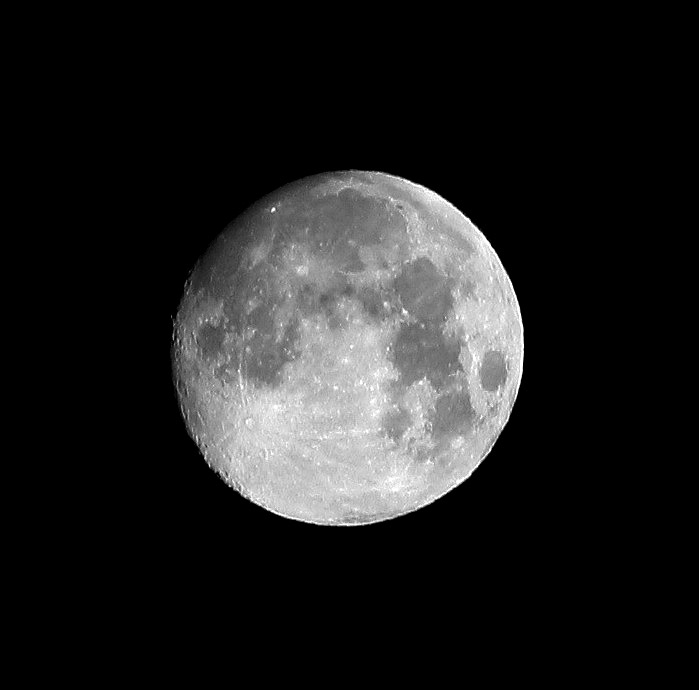
20070202
On most topics, I consider myself to be "trainable". That is a good thing, otherwise I would have have committed some unspeakable act(s) due to frustration. Taking shots of the moon, at night, with other lights nearby is quite difficult. Recently, we had several nights of remarkably clear weather (for Seattle). On the first day, I got out of bed a bit late. When I walked into the living room, I saw a great view of the moonlight reflecting off Elliot Bay. Recognizing the opportunity, realizing that these scenes last only moments I sprung into action. Gladly, my equipment was close, so I hustled to set up the tripod and camera on the balcony. If you note the date on this post, you will realize this was during the dead of winter. Knowing that time was short, I attempted to take shortcuts to get setup while the scene was at its peak. Forsaking shoes and a coat, I had the kit assembled and began shooting.
Immediately, I had issues. Notes to self: 30 degree concrete and bare feet don't mix well for more than a few seconds; frozen fingers cannot operate controls and push small buttons; failure to mechanically stabilize the camera will result in blurred shots. While some of these claims are obvious, sometimes you have to learn the hard way. Since I was caught off guard, I had just about every issue one could have under the circumstances: dead batteries (yes, plural since the backup battery in the desk was also dead due to extended storage), cold hands, cold feet, blurry images due to mechanical instability, blurry images due to fog on the optics, many simple mistakes due to just being sleepy and not thinking clearly, etc.
On the end of day one, I had exactly one shot that was possibly a keeper. But, I also had a much keener appreciation for being prepared in general. And, a solid understanding of what they say in some of the photographic text books about taking night shots.
The photos below are the result of these efforts.

This shot of the moon was the only photo from the first night that was worth keeping out of perhaps 30 taken. The moon was not completely full, as can be seen from the shadow on the upper left. What you cannot see if the effort that I put into cleaning the image with both Aperture and Photoshop to get rid of motion blur. The lesson here is several fold. First lesson: a heavy camera needs a beefy tripod. My Canon 1DsM2 slr body is about 3 pounds. With my 28-300 zoomer lens, it is close to 7 pounds. My ball head was chosen specifically because it was capable of holding a heavy load securely. But, the tripod is a travel version, purchased specifically to fit in my roll-aboard luggage. Four segments, carbon fiber, blah, blah. The news is that a heavy load on a carbon fiber 'pod will resonate. Ring like a bell, in fact, due to the inerrant stiffness of the carbon fiber. You must insure that the optical platform is quiet before shooting the shot. Second lesson: mirror lockup is your friend. This feature retracts the mirror before the shutter is fired, allowing the optical platform to "settle down" before actually performing an exposure. In my sleepy haste, I had not engaged the mirror lockup, thereby insuring that the whole assembly would ring like a bell with each shot. And, since this was shot at 300mm (high zoom), it amplifies the effect of this phenomena. Third lesson: time delay on shutter release is not as good as using a remote control. Since I was inspecting the shots as they were being taken, I was aware that there were issues. I suspected that it was my hands on the shutter release button that were causing the blurring, so I put the camera into "10 second delay" mode to allow the vibrations to damp out before releasing the shutter. Good idea, but without the mirror lockup, it would not matter. My frustrations aside (really, I knew this stuff but in my haste failed to account for the issues in the setup), this shot came out ok with a bit of touch up.
.jpg)
During the day, I thought about the issues that I had confronted and resolved to get up early and take another run at the problem. The weather was supposed to be clear again, so I got up at 0530, got appropriately dressed, used the "big" tripod and fully configured the camera with remote control before going into the cold. And, I put the equipment outside a few minutes before attempting to take a shot to allow the optics to "come to temperature" before shooting. This paid off, but as we will see, there are still a bunch of factors that can get in the way. The above shot was taken at ISO 100, 300 mm, f/14 at 1/50 metered with the camera's 2.5 degree internal spot meter and on auto-focus. In this shot, I did not adjust the contrast, which is why it appears "flatter" than the shot above. Also, the only adjustments were a very mild sharpening and cropping. No color adjustment, no contrast adjustment, basically the baseline JPEG Fine image out of the camera. This image is superior to the previous night's efforts with less processing since the optical platform was more stable due to a beefier tripod (3 segment heavy aluminum tube), mirror lockup engaged, and remote control dongle for shutter release. And, I was not stomping around the balcony with my bare feet freezing to the concrete. Lesson: thing ahead and be prepared. And, of course, haste makes waste.
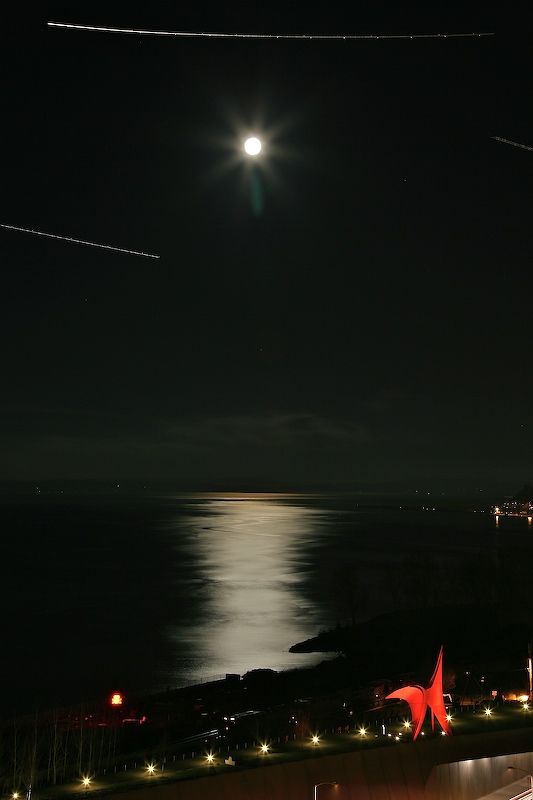
This shot is pretty good technically. Good depth of field, but then I set the camera to f/14 to get exactly that effect. While the moon is "blown out", that is generally to be expected. The baseline moon is about 1/125 at f/5.6 plus or minus a bit. The balance of the scene meters at 15 SECONDS at f/14. Hmm that must be about 15 stops of dynamic range, so something has to give. I elected to get the background rather than the moon. But, there were other factors that I did not consider. Notice the trails? These were aircraft on departure or approach to SeaTac airport. The pulses are their navigation lights. These were not on the menu, but it made an interesting side dish. Also, the very long exposure totally blurred out the wave action on the bay. But, to the camera's extreme credit, there is minimal ISO and exposure noise. Note the exposure of the passage under the bridge and "The Eagle" sculpture. And note the stars in the sky and clouds. Very impressive. Lesson: think about things that could appear in the scene before they happen and look for them before they happen.
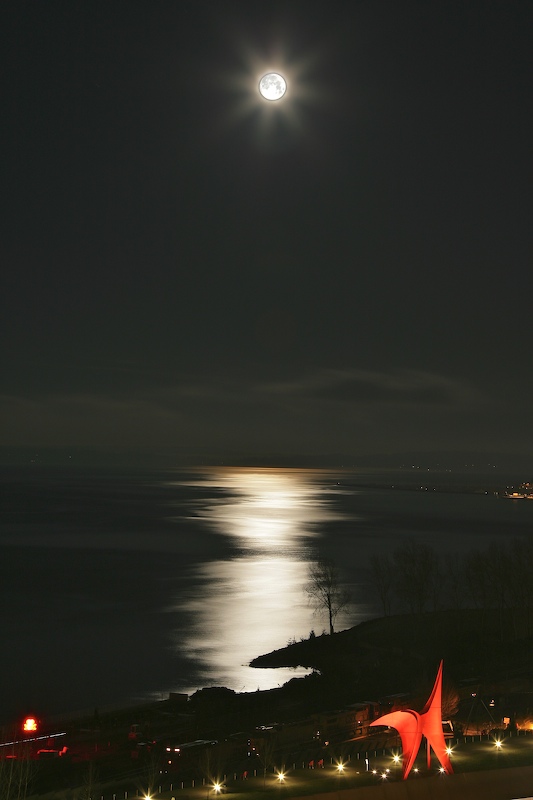
This was a really long shot but at a different focal length: 90mm, f/14 for 30 seconds at ISO 100. Notice that there is additional blurring of the reflections on the bay. And, note the additional detail on the clouds from reflected light from the moon and buildings. But, the moon came out great. Why? Photoshop is your friend. Due to the extreme dynamic range required to correctly render the scene, there is no way to get the moon and the balance of the shot in one photo. So, I took 2: the first set for an exposure time that would get the moon correctly exposed, the second for the background and then superimposed them with Photoshop. Lesson: understand the reaction of your camera to high dynamic range scenes and plan accordingly. Personally speaking, an overlay of this type is not a violation of "photographic integrity", but I am sure that others would disagree.
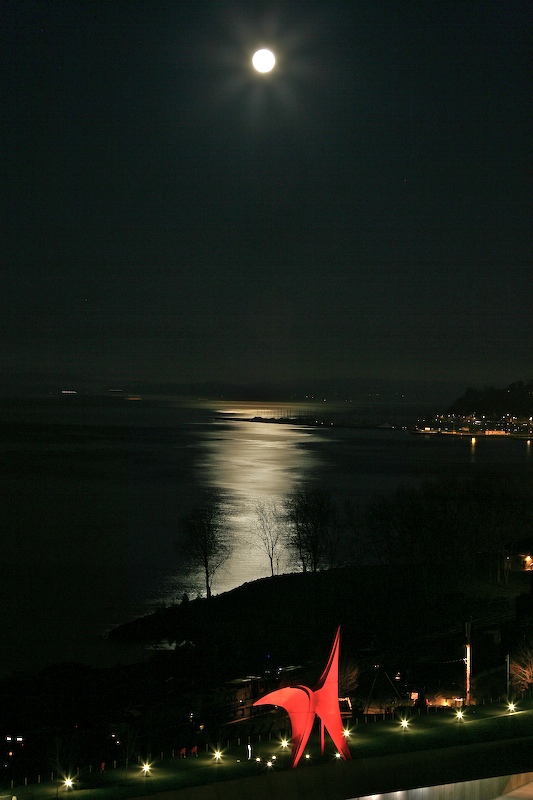
This shot is essentially the same as the one above, but without the overlay. But, the exposure time was limited to 8 seconds as opposed to 30. Note the better detail on the wave action. But, I also used the "shadows and highlights" to bring out some of the detail since it was quite dark. If you look carefully, you can see some of the processing artifacts that come from using this approach. There was a very wide dynamic range between the reflection on the bay and the Eagle.
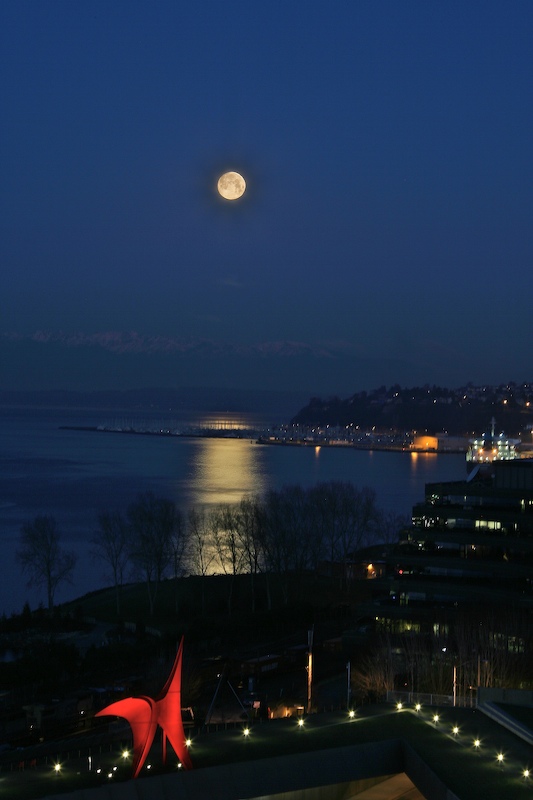
As the morning wore on, the sun rose and the moon set. This changed the colors in the scene dramatically and radically changed the exposure requirements. Note the blue color of the sky is starting to appear and the Olympic Mountains are becoming visible. This is an overlay with the background at f/14 for 5 seconds. Note that due to a refocus, the Eagle is not as crisp. Lesson: get the focus correct the first time. Relying on DOF is hit and miss.
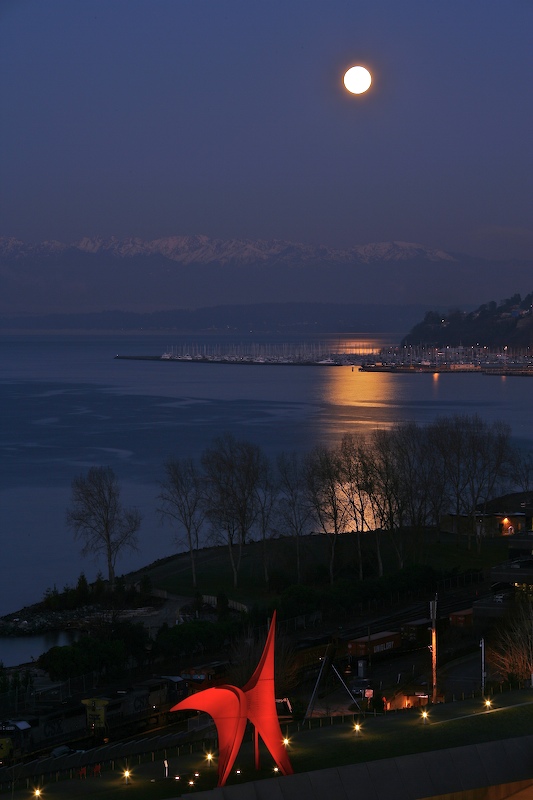
Same basic shot without the overlay. Note that the moon is fully blown out.
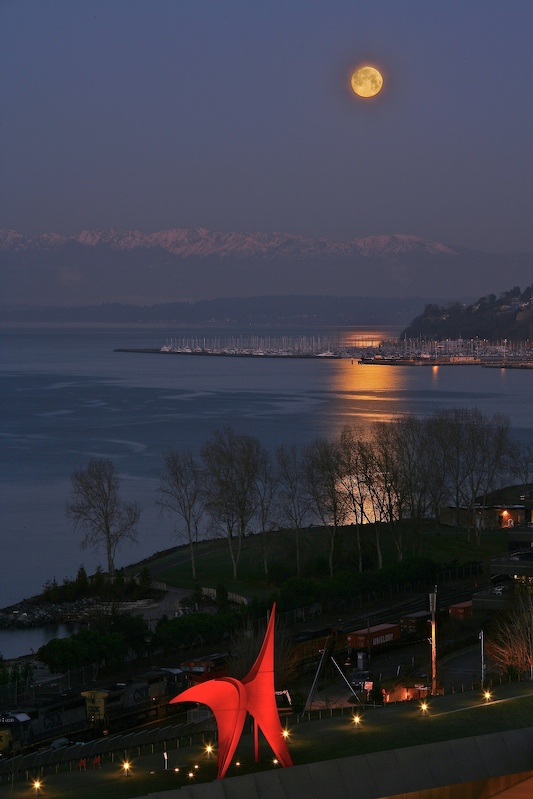
Another overlay, but notice the ring around the moon? The moon is getting low enough to have the clouds over the mountain creating a halo. Lesson: consider the effect of the ambient weather before making the shot.
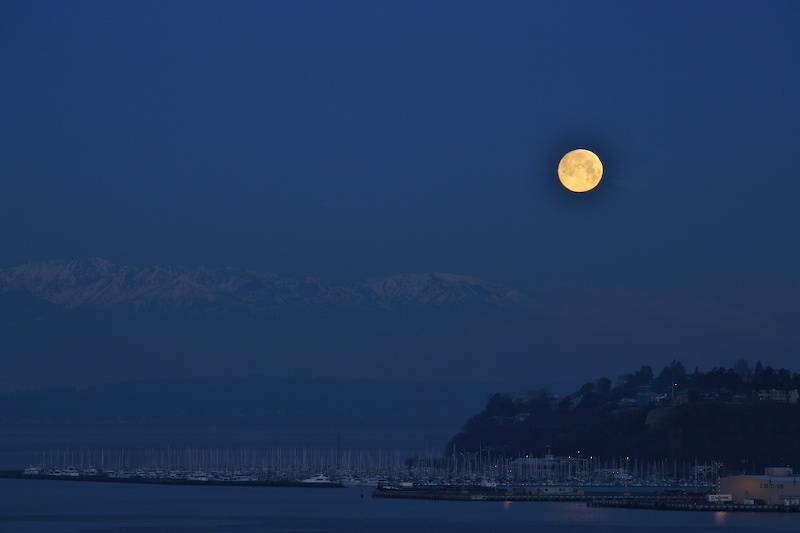
It was getting quite light now, but this shot is NOT an overlay, it is the real deal. I waited until the light clouds passed before shooting. And, I metered for the moon and used mild processing to get the balance of the shot. Lesson: timing is everything. Oh, luck sometimes factors in, but somebody once told me that "luck is preparation combined with opportunity". So true.
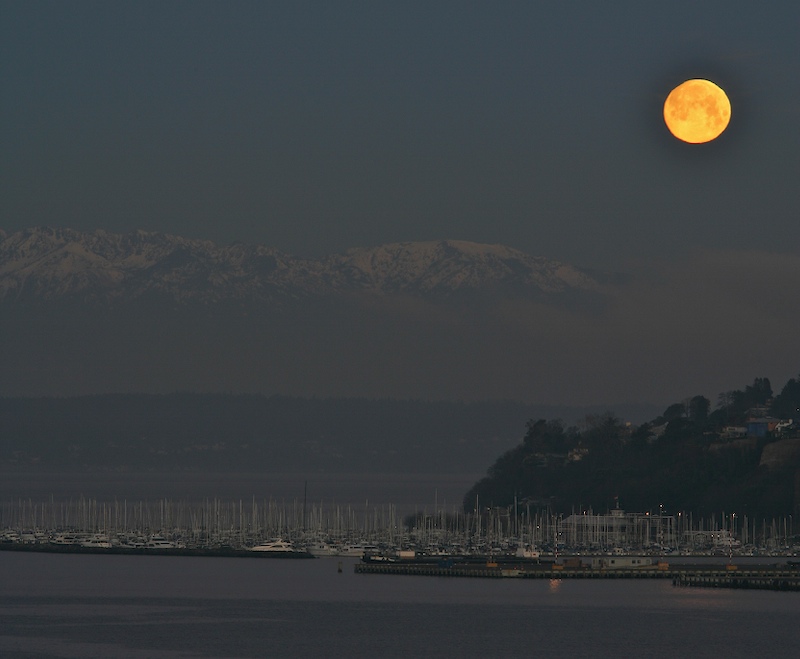
As the morning wore on, the clouds started to move in. Here, the low position of the moon results in a "lensing effect" of the atmosphere, changing the color and the apparent size of the moon. Also, the ambient light was now to the point where the dynamic range of the scene was within the capabilities of the camera. This shot was at 1/3 second at f/14. Lesson: wait for the right moment.
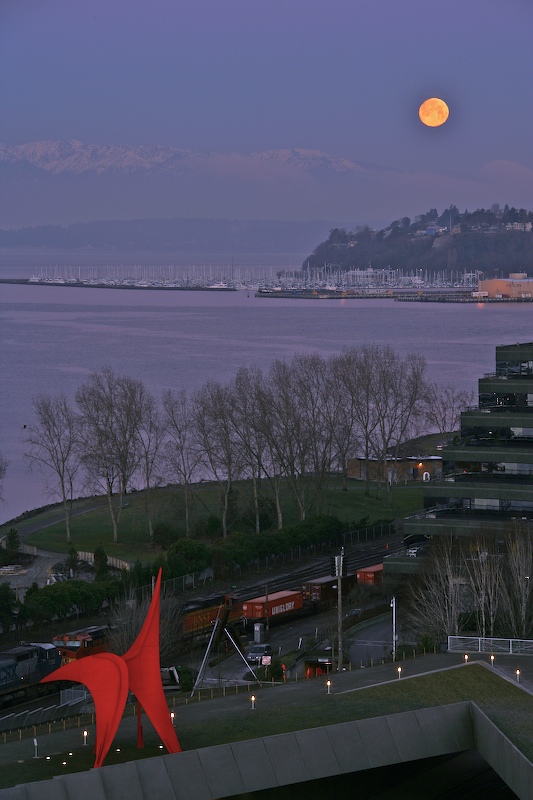
This is not an overlay, but rather the real image. The only processing was a mild shadows and highlight adjustment to balance out the deeper shadows in the foreground against the bright moon. This was 1/3 second at f/14, 160mm at ISO 100. Lesson: shoot a bunch of images at multiple settings; most will be "throw-aways", but there will be a few keepers too.
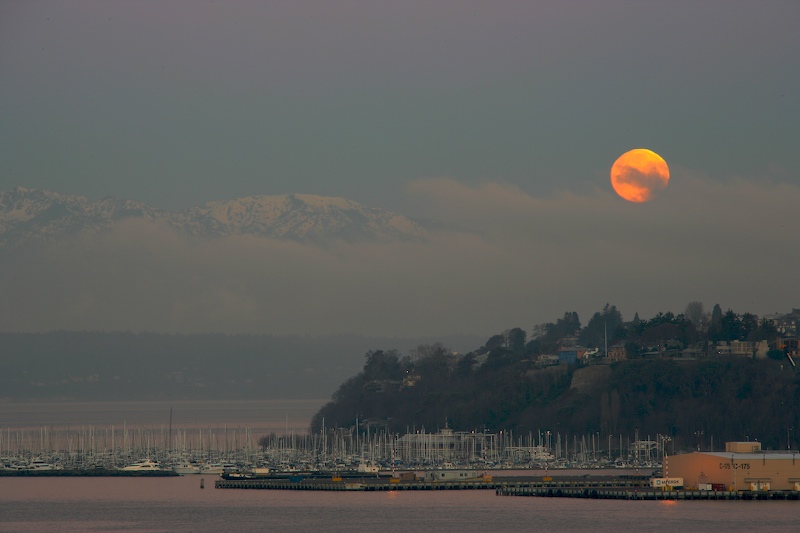
This was the last shot of the day as the weather was starting to block the moon. The only processing done here is mild sharpening. No shadow processing or color adjustment. Lesson: if you wait long enough, you might get the shot that you want.
When this was over, I had about 50 shots and 2 1/2 hours of effort into the game. And there was a number of hours of "Photoshop Phun" required to do adjustments. As a country doctor told me once when I was complaining about insomnia, "nobody has ever died from lack of sleep".